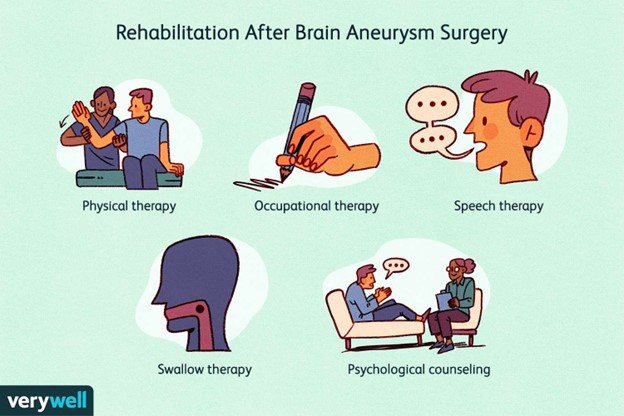Postoperative Care and Rehabilitation
Post-op Care and Rehabilitation for Aneurysms
- Intensive Care Unit (ICU) Monitoring: After surgical repair of an aneurysm, the patient is usually closely monitored in the ICU to assess vital signs, neurological status, and signs of complications.
- Pain Management: Adequate pain management is provided to ensure the patient's comfort and reduce postoperative pain.
- Wound Care: Careful monitoring and dressing changes for surgical incisions are essential to prevent infection and promote healing.
- Blood Pressure Management: Maintaining stable blood pressure is crucial post-surgery to prevent stress on the repaired blood vessel and reduce the risk of further complications.
- Early Mobilization: Encouraging early mobilization helps prevent complications such as blood clots and promotes faster recovery.
- Respiratory Care: Monitoring and supporting respiratory function is crucial, especially if the aneurysm is located in the thoracic region.
- Neurological Assessment: Frequent neurological assessments are conducted to monitor for any changes that might indicate complications affecting the brain or spinal cord.
- Fluid and Electrolyte Balance: Monitoring and managing fluid and electrolyte levels are vital to maintain overall health and support proper healing.
- Medication Management: The patient may receive medications, such as antihypertensives or anticoagulants, to manage blood pressure and prevent clot formation.
- Diet and Nutrition: A well-balanced diet is important for wound healing and overall recovery.
Rehabilitation for Aneurysms
- Physical Therapy: Physical therapy focuses on improving strength, mobility, and function. It may include exercises to improve walking, balance, and overall physical conditioning.
- Occupational Therapy: Occupational therapy helps patients regain skills necessary for daily activities and promotes independence.
- Speech Therapy: For aneurysms affecting the brain, speech therapy may be needed to address any speech or language deficits that may have occurred.
- Neurological Rehabilitation: Patients with neurological deficits may benefit from specialized neurological rehabilitation programs tailored to their needs.
- Psychological Support: Rehabilitation often involves psychological support to address emotional and cognitive challenges that may arise after aneurysm repair.

Post-op Care and Rehabilitation for Peripheral Vascular Disorders:
- Wound Care: For individuals who underwent procedures like angioplasty, stent placement, or bypass surgery, careful wound care and monitoring are essential to prevent infection and promote healing.
- Activity and Mobility: Gradual and supervised mobilization is encouraged to prevent complications and improve blood flow.
- Medication Management: Compliance with prescribed medications, such as antiplatelets and statins, is essential to manage the underlying vascular condition and prevent complications.
- Compression Therapy: For individuals with venous insufficiency or chronic venous ulcers, compression therapy may be utilized to improve blood flow and promote wound healing.
- Lifestyle Modifications: Encouraging and supporting lifestyle changes,
Nursing Test Bank
Naxlex Comprehensive Predictor Exams
Questions on Postoperative Care and Rehabilitation
Correct Answer is A
Explanation
Correct Answer is C
Explanation
Correct Answer is C
Explanation
Correct Answer is C
Explanation
Correct Answer is B
Explanation
Correct Answer is A
Explanation
Correct Answer is C
Explanation
Correct Answer is C
Explanation
Correct Answer is B
Explanation
Correct Answer is A
Explanation
Correct Answer is C
Explanation
Correct Answer is A
Explanation
Correct Answer is A
Explanation
Correct Answer is A
Explanation
Correct Answer is C
Explanation
Correct Answer is A
Explanation
Correct Answer is D
Explanation
Search Here
Related Topics
- Enteral nutrition (EN) - Blood and Cardiovascular Disorders
- Mobility devices: crutches, canes, continuous passive ROM machine. - Blood and Cardiovascular Disorders
- Bandaging - Blood and Cardiovascular Disorders
- IV insertion - Blood and Cardiovascular Disorders
- Immunodefeciency disorders - Blood and Cardiovascular Disorders
More on Nursing
Free Nursing Study Materials
Access to all study guides and practice questions for nursing for free.
- Free Nursing Study Trials
- Free Nursing Video tutorials
- Free Nursing Practice Tests
- Free Exam and Study Modes
- Free Nursing Revision Quizlets
